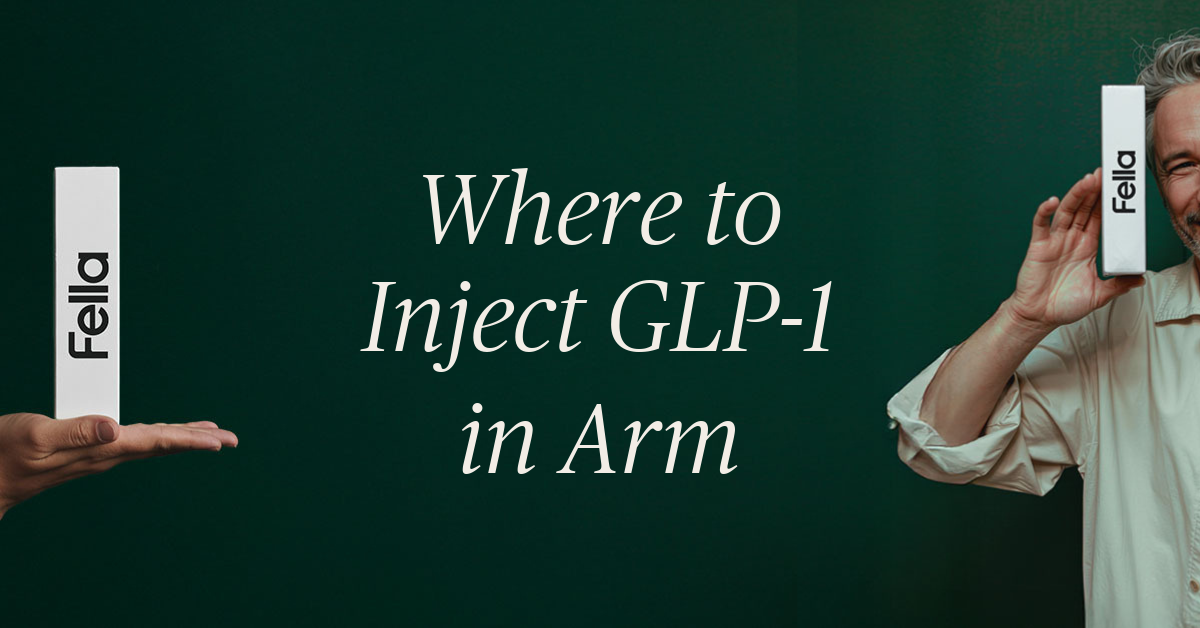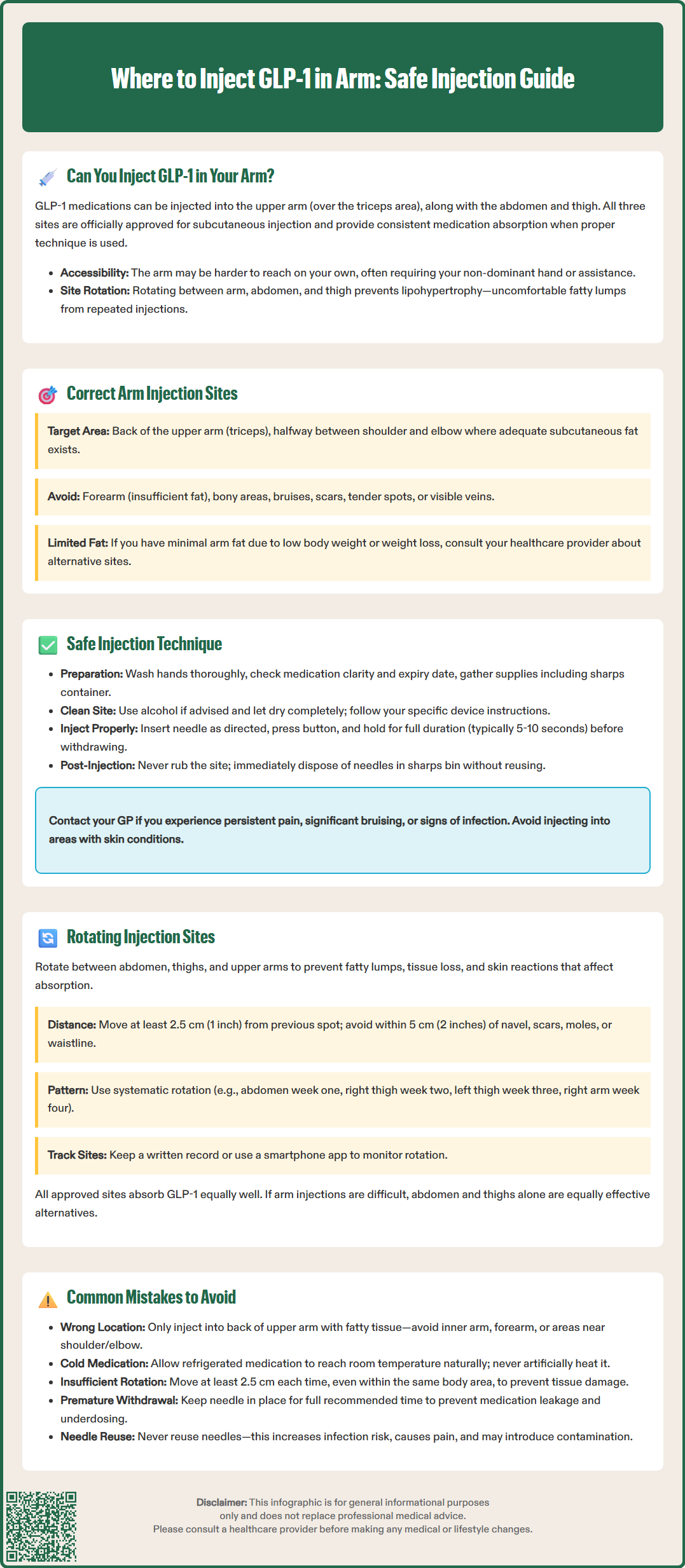
GLP-1 receptor agonist medications, including semaglutide (Ozempic, Wegovy), dulaglutide (Trulicity), liraglutide (Victoza, Saxenda), and tirzepatide (Mounjaro), can be injected into the upper arm as an approved subcutaneous injection site. Whilst the abdomen and thigh are more commonly used, the back of the upper arm offers a suitable alternative for patients seeking to rotate injection sites or experiencing discomfort elsewhere. Proper technique is essential to ensure medication efficacy and minimise complications such as bruising or lipohypertrophy. This guide explains where to inject GLP-1 medications in the arm, correct technique, site rotation strategies, and common mistakes to avoid for safe, effective treatment.
Quick Answer: GLP-1 medications should be injected into the fatty tissue on the back of the upper arm, approximately halfway between the shoulder and elbow, using proper subcutaneous injection technique.
Yes, you can inject GLP-1 receptor agonist medications into your arm, though it is not always the most commonly recommended site. GLP-1 medications—including semaglutide (Ozempic, Wegovy), dulaglutide (Trulicity), liraglutide (Victoza, Saxenda), and tirzepatide (Mounjaro)—are administered subcutaneously, meaning they are injected into the fatty tissue just beneath the skin rather than into muscle.
The approved injection sites for most GLP-1 medications include the abdomen (stomach area), thigh, and upper arm. The arm is a suitable alternative when other sites become uncomfortable, develop lipohypertrophy (fatty lumps), or when patients prefer variety in their injection routine. However, the arm can be more challenging to access independently, particularly for individuals with limited mobility or dexterity, as it typically requires using the non-dominant hand or assistance from another person.
MHRA-approved product information (SmPCs and PILs) confirms that the abdomen, thigh or upper arm are acceptable sites for subcutaneous GLP-1 injections. According to these official sources, the efficacy and absorption of the medication remain consistent across approved sites when proper technique is used. The upper arm site refers specifically to the upper arm (subcutaneous fat over the triceps area), where there is adequate subcutaneous fat, rather than the forearm or other areas with insufficient fatty tissue.
Patients should always follow the specific instructions provided with their prescribed GLP-1 medication, as some formulations may have particular guidance. Many product information leaflets note that upper-arm injections may require assistance from another person. If you are uncertain about injection sites or technique, consult your GP, practice nurse, or diabetes specialist nurse for personalised instruction and demonstration.

Mounjaro® is the most innovative GLP-1 medication proven to dramatically curb appetite, hunger, and cravings to help professional men achieve substantial weight loss.
Start Here
Wegovy® is a weekly injectable GLP-1 medication with proven effectiveness in reducing appetite, hunger, and cravings to help busy professionals lose significant weight.
Start HereWhen injecting GLP-1 medication into the arm, the correct anatomical location is the back of the upper arm, specifically the fatty tissue over the triceps muscle. This area, located between the shoulder and elbow, typically has sufficient subcutaneous fat to accommodate the injection whilst minimising discomfort and ensuring proper medication absorption.
To identify the correct injection zone:
Locate the area on the outer back portion of the upper arm, approximately halfway between the shoulder and elbow
The injection site should be in the fatty tissue, not near the elbow joint or shoulder
Ensure you can raise a skinfold if needed, as instructed in your product information leaflet or by your healthcare professional
Avoid areas that are bony, bruised, tender, scarred, or have visible veins
The back of the upper arm is preferred because it generally contains more subcutaneous fat than the inner arm or forearm. The forearm is not an approved injection site according to product information leaflets, as it lacks adequate fatty tissue and has more nerve endings, which could affect medication delivery.
Practical considerations include the fact that most people will need to use their non-dominant hand to inject into their dominant arm, or vice versa. Some patients find it helpful to use a mirror or ask a family member, carer, or healthcare professional to assist with arm injections, particularly when first learning the technique. If you have limited subcutaneous fat in your arms due to low body weight or significant weight loss, discuss alternative injection sites with your healthcare provider, as the abdomen or thigh may be more appropriate.

Proper injection technique is essential to ensure medication efficacy, minimise discomfort, and reduce the risk of complications such as bruising, infection, or lipohypertrophy. Follow these steps for safe GLP-1 injection into the arm:
Preparation:
Wash your hands thoroughly with soap and water
If recommended in your product information leaflet, allow the medication to reach room temperature (often around 15–30 minutes). Do not heat artificially
Check the medication for clarity, colour, and expiry date—do not use if it appears cloudy, discoloured, or contains particles
Gather supplies: the pre-filled pen or syringe, alcohol wipe (if recommended), and a sharps container
Injection technique:
Clean the injection site with an alcohol wipe if advised by your healthcare provider, and allow the skin to dry completely
Follow the exact technique in your medicine's PIL (e.g., autoinjectors are pressed flat against the skin; some devices do not require pinching)
For standard pen devices that require a skinfold, gently pinch the skin on the back of your upper arm
Hold the device as instructed in your specific product information
Insert the needle according to your device instructions
Press the injection button and hold for the full duration specified (typically 5–10 seconds for pens; some autoinjectors require waiting for a second click)
Withdraw the needle as instructed and release the skin fold if used
Do not rub the injection site afterwards
Dispose of the needle immediately in a sharps bin—never reuse needles. Obtain a sharps bin via your GP, pharmacy or local council and return when full as instructed
Important safety considerations include never injecting into areas with active skin conditions, inflammation, or infection. If you experience persistent pain, significant bruising, or signs of infection (redness, warmth, swelling, discharge), contact your GP promptly. Patients taking anticoagulants or with bleeding disorders should discuss injection technique with their healthcare provider, as they may require additional precautions.
Site rotation is a crucial practice when administering GLP-1 medications regularly, as it helps prevent lipohypertrophy (fatty lumps), lipoatrophy (loss of fatty tissue), and localised skin reactions. Repeatedly injecting into the same spot can lead to tissue changes that affect medication absorption and may cause discomfort or cosmetic concerns.
Recommended rotation strategy:
Rotate between the three approved sites: abdomen, thighs, and upper arms
Within each site, move the injection location by at least 2.5 cm (1 inch) from the previous injection
Establish a systematic pattern—for example, abdomen for week one, right thigh for week two, left thigh for week three, right arm for week four, then repeat
Keep a written record or use a smartphone app to track injection sites and dates
Avoid injecting within 5 cm (2 inches) of the navel, scars, moles, or the waistline
Absorption considerations: Product information for GLP-1 medications indicates no clinically relevant differences in absorption between approved injection sites. Consistent site rotation is important primarily to reduce the risk of local reactions rather than for absorption concerns.
NICE guidance (NG28) on type 2 diabetes management emphasises the importance of proper injection technique and site rotation as part of comprehensive diabetes care. If you develop lumps, persistent bruising, or skin changes at injection sites, do not inject into these areas and consult your healthcare provider. They may recommend adjusting your rotation pattern or examining your injection technique. Patients who find arm injections difficult to perform independently should not feel obligated to use this site—the abdomen and thighs are equally effective alternatives that may be easier to access.
Understanding and avoiding common injection errors can significantly improve treatment outcomes and reduce adverse effects. Here are the most frequent mistakes patients make when injecting GLP-1 medications into the arm:
Injecting into the wrong area of the arm: Many patients mistakenly attempt to inject into the inner arm, forearm, or areas too close to the shoulder or elbow. These locations lack adequate subcutaneous fat and may result in painful injections, bruising, or poor medication absorption. Always use the back of the upper arm where fatty tissue is most abundant.
Failing to follow device-specific instructions: Different GLP-1 devices have specific requirements. For example, some autoinjectors are pressed flat against the skin without pinching, while pen needles may require a skinfold. Follow the hold time/click guidance in your specific PIL (e.g., some pens require waiting for a second click).
Using the same injection spot repeatedly: Injecting into the identical location week after week leads to lipohypertrophy and tissue damage. Even when using the arm consistently, move the injection site by at least 2.5 cm each time.
Injecting cold medication: Administering GLP-1 medication directly from the refrigerator increases injection discomfort and may affect absorption. Allow the medication to reach room temperature naturally—never heat it artificially.
Removing the needle too quickly: Withdrawing the needle immediately after pressing the injection button, rather than waiting the recommended time in your PIL, can result in medication leakage and underdosing.
Reusing needles: This practice increases infection risk, causes needle blunting (leading to more painful injections), and may introduce air bubbles or contamination.
When to seek medical advice: Contact your GP or diabetes nurse if you experience persistent injection site reactions, unexplained bruising, signs of infection, or if you are uncertain about your injection technique. Many GP surgeries and diabetes clinics offer injection technique reviews, which can be valuable for optimising your treatment. If you develop symptoms such as severe persistent abdominal pain with vomiting, or signs of pancreatitis whilst taking GLP-1 medications, seek urgent medical help (call 999 or go to A&E). You can report any suspected side effects to the MHRA Yellow Card scheme, which helps monitor medicine safety.
No, the forearm is not an approved injection site for GLP-1 medications as it lacks adequate subcutaneous fat for proper medication absorption. Only the back of the upper arm, abdomen, and thigh are approved sites according to MHRA product information.
You should rotate between approved injection sites (abdomen, thigh, upper arm) and move each injection at least 2.5 cm from the previous spot to prevent lipohypertrophy and tissue damage. Establishing a systematic weekly rotation pattern is recommended.
Many patients can self-inject into the back of the upper arm using their non-dominant hand, though some product information leaflets note that assistance may be required. If you have limited mobility or dexterity, a family member, carer, or healthcare professional can help, or you may prefer using the abdomen or thigh instead.
All medical content on this blog is created based on reputable, evidence-based sources and reviewed regularly for accuracy and relevance. While we strive to keep content up to date with the latest research and clinical guidelines, it is intended for general informational purposes only.
DisclaimerThis content is not a substitute for professional medical advice, diagnosis, or treatment. Always consult a qualified healthcare professional with any medical questions or concerns. Use of the information is at your own risk, and we are not responsible for any consequences resulting from its use.